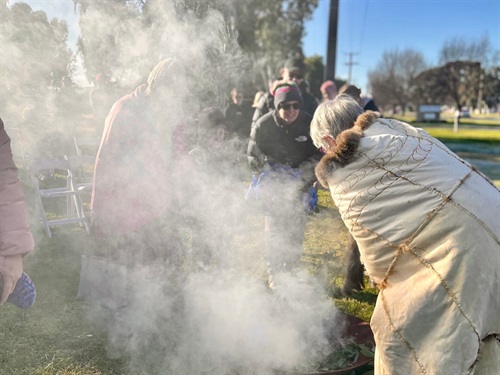

The Taungurung people shared a common bond in moiety affiliation with the other tribes. Their world was divided into two moieties: Bundjil (Wedge Tail Eagle) and Waang (Crow). Members of the tribe identified with one or the other of these moieties and it was their moiety which determined the pattern for marriage between individuals, clans and tribes and transcended local allegiances by obliging clan members to find spouses from some distant clan of the opposite moiety either within or outside their Wurrung (language group).
The nature of the Taungurung people enabled us to utilise the resources available in our vast country. Our ancestors had an intimate knowledge of their environment and were able to sustain the ecology of each region and exploit the food available.
A staple plant food was the Mirnong (Yam Daisy) which provided a reliable source of carbohydrate. Other plants such as the Bracken Fern (food and medicine), the Tree Fern, Kangaroo Apple and Cherry Balert were a valuable food source and can still be seen growing on Taungurung country today.
Dhulangi (Stringy Bark) was used to construct Yilam (Shelters) or to weave binak (Baskets). Fibrous plants, such as Dulim (Tussock Grass) produced Burrdi-am (Twine) for Garrtgirrk (Nets) while other tree species were utilised for their timber to fashion Malga (Shield), Gudjerron (Clubs), Wanggim (Boomerangs). Daanak (Water Carriers) and Gorong (Canoes). The rich resources of the permanent rivers, creeks, tributaries and associated floodplains enabled Taungurung to people to access an abundance of fish and other wildlife. Fish were speared and trapped while water birds were netted and Marram (Kangaroo), Goorbil (Koala), and Barramul (Emu) provided nourishing food.
The pelts from the Walert (Native Possum) were sewn together to form Gugra (Cloak ideal for the cold and wet conditions. Plants such as Karradjong provided fibres to weave Garrtgirrk (Nets) for harvesting the nutritious Debera (Bogong Moth). In the summer the Taungurung people would travel south for the Debera season and then head back northwards when the weather cooled.
The story of the carvings by Taungurung traditional owner Michael Harding
The first shield as you look at it from the entrance represents the nine clans of the Taungurung; Budhera-bulok (Bundjil), Leuk-yilam (Waang), Mummum-yilam (Bundjil), Naterrak-bulok (Waang), Nira-bulok (Waang), Waring-yilam-bulok (Bundjil), Yaran-yilam (Bundjil), Yiran-yilam-bulok (Bundjil), Yawang-yilam-bulok (Waang). As you can see at the end of the name of each clan there is the name of the moiety or skin group (Bundjil–Wedge Tailed Eagle) and Waang (Crow) for the particular clans. There are nine symbols on that shield that you’re looking at, of which five are red (Bundjil) and four are black (Waang) these are the symbols I use to represent the clans.
The reason I’m showing you the different moieties/skin groups is in traditional times before European people came here these were the way in which our old people organised marriages. It is a paternal society that works something like this. The Elders of any particular clan would get together and organise marriage and a Bundjil clan person could only marry a Waang clan person, and the women of either of these groups went to the man’s clan country to live (if she was from a Bundjil clan, she would marry a man from Waang clan and go to his clan country). The shield on the opposite side represents the wings of both of these birds with Bundjil having red wings and Waang having black wings.
The Eel trap was made by the late Aunty Joyce Moate who was a basket maker for most of her life and this depiction of one of her pieces of work is a dedication to her as this is her clan area. Aunty Joyce has passed on her knowledge to many Taungurung women so that the tradition lives on with our women today. Lastly this is a story that we share with you as we are the First People of the Rivers and Mountains in this area.
Source: taungurung.com.au/culture-2/